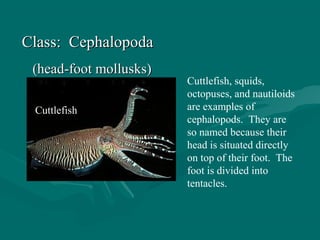
Cephalopods: Head-Foot Mollusks
- 1. Class: CephalopodaClass: Cephalopoda (head-foot mollusks)(head-foot mollusks) Cuttlefish, squids, octopuses, and nautiloids are examples of cephalopods. They are so named because their head is situated directly on top of their foot. The foot is divided into tentacles. Cuttlefish
- 2. CephalopodsCephalopods • The most complex mollusks and also the mostThe most complex mollusks and also the most complex invertebrate.complex invertebrate. • The mantle encloses everything except head andThe mantle encloses everything except head and tentacles.tentacles. • Mantle is very muscularMantle is very muscular – Mantle acts as pump to bring large quantities ofMantle acts as pump to bring large quantities of water into the cavity.water into the cavity.
- 4. CephalopodsCephalopods • External shells are absent in all cephalopodsExternal shells are absent in all cephalopods except?except? – NautiloidsNautiloids
- 5. This is a chambered nautilus. Its foot is easily visible here (divided into many tentacles). The arrow is pointing to a leathery cover that works somewhat like an operculum, closing the aperture when the animal is at rest or in danger.
- 6. CephalopodsCephalopods • Squids and cuttlefish have an internal shell thatSquids and cuttlefish have an internal shell that is made of 3 layers with gas-filled spacesis made of 3 layers with gas-filled spaces between each layerbetween each layer • helps with buoyancy.helps with buoyancy. – CuttleboneCuttlebone
- 7. Octopuses are the most familiar cephalopods. They have eight arms, all equipped with powerful suckers, and eyes capable of sight that rivals our own.
- 9. Below: The eyes are elevated and capable of excellent vision, even in the dark. Above: The suckers on the ventral surface of the arms are used to capture and grip food, which consists of crabs, lobsters, and shrimp.
- 10. A female octopus stays with their eggs until they hatch, then she dies. This hatchling is still with the unhatched eggs from its clutch.
- 11. CephalopodsCephalopods • Are the only mollusk to have a closed circulatoryAre the only mollusk to have a closed circulatory system.system. • This means blood is confined to vesselsThis means blood is confined to vessels throughout its circuit around the body.throughout its circuit around the body.
- 12. The blue-ringed octopus is considered to the most venomous animal in the world, Second is the box jellyfish. Both animals are native to the Great Barrier Reef of Australia.
- 13. Squids are also cephalopods. Instead of eight arms, they have ten. They are fast swimmers. The fins along the sides of their body facilitate their ability to swim fast.
- 14. This giant squid was found dead. This species lives at great depths, perhaps greater that one mile. An adult has never been collected or seen alive.
- 16. Cuttlefish are very similar to squids. Their head is smaller and their tentacles are shorter. Some of them have incredible color patterns.
- 17. ReproductionReproduction • Are DieciousAre Diecious • Male and female look different.Male and female look different. • Males consists of testes that produce sperm andMales consists of testes that produce sperm and structures that encase sperm into packets calledstructures that encase sperm into packets called spermatophoresspermatophores..
- 18. ReproductionReproduction • Females produce large yolk eggs and surroundFemales produce large yolk eggs and surround them with a gel-like case that hardens when it isthem with a gel-like case that hardens when it is exposed to seawater.exposed to seawater.
- 19. ReproductionReproduction • Males have a specialized tentacle calledMales have a specialized tentacle called hectocotylus that is used to transfer thehectocotylus that is used to transfer the spermatophores.spermatophores.
- 21. ReproductionReproduction • The hectocotylus transfers the spermatophoresThe hectocotylus transfers the spermatophores to the female’s mantle cavity near the oviduct.to the female’s mantle cavity near the oviduct. • The eggs move out of the body through theThe eggs move out of the body through the oviduct and then the mantle cavity and areoviduct and then the mantle cavity and are fertilized in the oviduct.fertilized in the oviduct.
- 22. ReproductionReproduction • The eggs are then attached to the substrate.The eggs are then attached to the substrate.
- 23. The chiton’s shell is divided into many plates, hence the class name Polyplacophora, “bearing many plates”. Class: Polyplacophora - ChitonsClass: Polyplacophora - Chitons
- 24. THE END